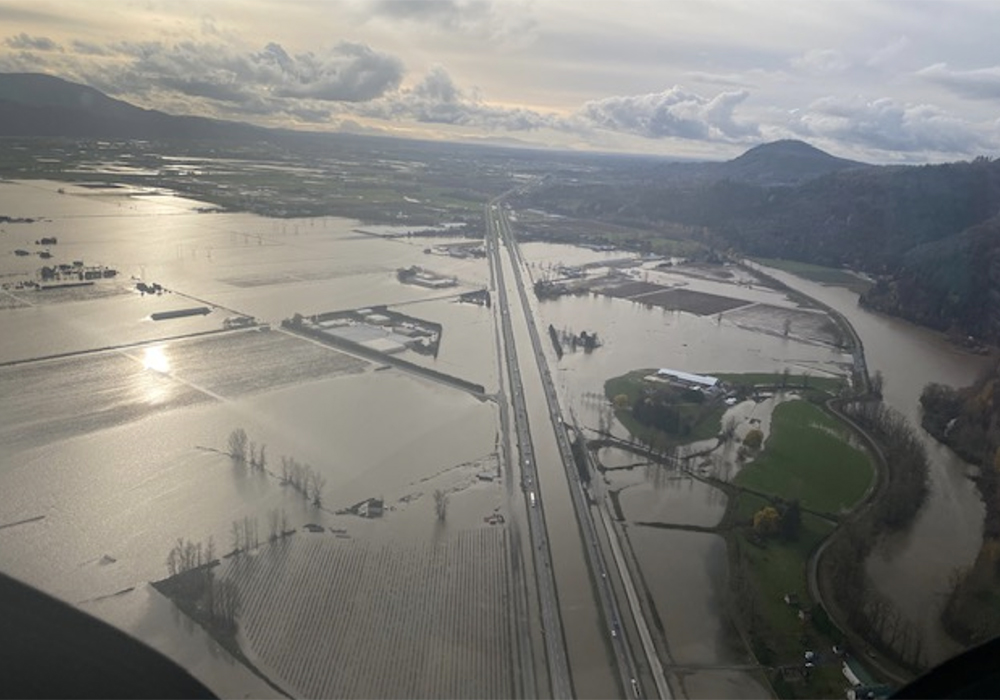More rain forecast for B.C., Canadians step up to help

British Columbia braced itself for further rainfall as farmers dealt with the aftermath of unprecedented flooding, with the provincial government emphasizing the generosity of Canadians who have donated to the Red Cross.
“This is historic weather intensified by climate change,” B.C. Minister of Public Safety and Solicitor General Mike Farnworth said Nov. 28. As a result, the federal and provincial governments have formed a working group to help “families, businesses and communities affected by the extreme weather that we’re seeing.”
Both governments are matching donations to flood relief by the Canadian Red Cross, tripling the value of each person’s donation, he said. “Thanks to funds from the province and the generosity of Canadians to date, the Canadian Red Cross has distributed $2.25 million to people who were evacuated due to the flooding.”
The B.C. Agriculture Council said donations to support farmers can be made at its website, https://bcac.ca/. It had received a total of $100,000 as of Nov. 19.
Farnworth warned Nov. 24 that the “ground is already saturated, which means that even a routine storm for this time of year can cause rivers and streams to rise faster and potentially flood.”
Record-setting rainfall that began Nov. 14 caused flooding that severed road and rail links, forcing B.C. to declare a state of emergency on Nov. 17. The Sumas Prairie area in the Fraser Valley near Abbotsford, which is the site of a former lake drained to create farmland in the 1920s, was particularly hard hit.
Although the Fraser Valley is the location of much of B.C.’s dairy, poultry and egg sectors, everyone from blueberry, raspberry and vegetable producers to flower growers and fish farmers were also affected. Abbotsford Mayor Henry Braun has said the damage in his community alone is likely to total $1 billion.
B.C. Agriculture Minister Lana Popham said Nov. 24 that “thousands of poultry and I think 20,000 hogs” had died.
However, she said Nov. 25 that she would not release the death toll of farm animals killed by the disaster.
“Each time we update those numbers, it turns out to be another traumatic moment for our livestock producers, and to tell you the truth, they don’t really want to go there right now. They’re still in the emergency and dealing with these events.”
Farmers in sectors ranging from dairy to poultry “lost just about everything” within a matter of hours, said Jack Dewit, president of the B.C. Pork Producers Association. The disaster affected one pork farmer who had three barns, he added.
Producers must clean up the mess caused by floodwater contaminated with everything from fuel and manure to animal carcasses, he said. “It’s going to be gut-wrenching for a lot of people. There’ll be visual images that they will never forget.”
About 50,600 acres of B.C. farmland were affected by flooding, with about 35,000 acres of that designated as agricultural land reserve. Popham has said 959 farmers were under evacuation order as of Nov. 19, with 164 under evacuation alert.
A tentative estimate Nov. 26 of the losses faced by poultry producers was more than 100,000 meat birds, said Ray Nickel, director of the B.C. Chicken Marketing Board. “We know that it will be a fair number higher than that.”
However, he expected it will be less than the losses experienced during the record-breaking heat dome that hit B.C. in the summer, when producers lost more than 400,000 meat birds.
Several producers were already able to get through the disposal, cleaning and disinfection process, he said. “And actually as of (Nov. 26), we have a farm placing birds today, so that’s a pretty amazing piece of work considering what that looked like over there.”
As part of a preliminary estimate, the B.C. Dairy Association said Nov. 23 that 500 cattle had been lost, with about 6,000 evacuated to other farms in the Abbotsford, Agassiz and Chilliwack areas.
“Sixty-two farms in the Abbotsford and Yarrow areas were under evacuation orders at the peak last week.”
The lack of passable roads left farmers in many sectors unable to transport their products, with dairy producers forced to dump their milk. However, about 80 percent of the milk in B.C. was being shipped for processing as of Nov. 23, “which is sufficient to meet the province’s immediate need for fluid milk.”
An online survey of beef producers has been launched by the B.C. Cattlemen’s Association to help it determine how to best support 70 to 100 members hit by flooding. The disaster has particularly affected producers in the Merritt and Penticton areas, said general manager Kevin Boon.
Although no losses in cattle had been reported as of Nov. 25, he said infrastructure ranging from houses and barns to fences, corrals and irrigation equipment was heavily damaged. Feed was also washed away or spoiled, and “we’ve seen a lot of fields that are completely gone.”
Source: www.producer.com

